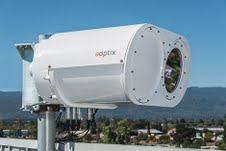CAMPBELL, Calif. – A small company in California with a defense-contractor pedigree is looking to make a big splash in telecom networks, using a new dual-technology wireless connection for mobile backhaul and hopefully luring fiber-happy tier-one carriers to adopt their solution with the promise of lower costs than fiber and “5-9s” reliability.
AOptix, based in Campbell, already has its Intellimax wireless product in several trials, including a tier-one North American wireless carrier and Anova Networks, which provides financial institutions with very low-latency connections. AOptix uses both radio frequency and optical light to send data, with both links sending the same data simultaneously in order to maintain high reliability regardless of weather conditions. A real-time packet selection algorithm chooses the best data from across the two frequencies in order to ensure high fidelity.
AOptix has a background as a government contractor for the military, with its adaptive optics technology first being used for image correction for deep-space telescopes in order to adjust for atmospheric distortion, according to Dean Senner, chairman and CEO of the company. Venture capital firm Kleiner Perkins Caufield & Byers was one of the founding investors in the privately-held company, which spent 10 years developing and proving out adaptive optics. Eventually AOptix was tasked with solving the problems of in-air data communications for military data. The military previously flew missions to collect data and pulled a physical hard drive at the end of the flight in order to retrieve the recorded sensor data, Senner said; AOptix’s technology allowed data to be transferred in real-time between aircraft flying at mach speed, or to the ground, via four-inch laser beams sent to a four-inch receiver target, at up to 80 gigabits per second over distances as far as 200 kilometers.
But it wasn’t until the introduction of the original iPhone, and the attendant network issues due to the impact of increased data usage on mobile backhaul, that AOptix found one of the verticals where it felt its technology could have the most impact. (The other is identity verification – AOptix’s iris recognition technology is already in use at multiple overseas airports. The company even has a mobile version of that technology which fits like a sleeve on an iPhone.)
Intellimax is designed to offer fiber-like capabilities in terms of speed and reliability, over long distances between two and eight kilometers, Senner said, at a fraction of the cost of fiber.
“It can be prohibitively expensive trench new fiber. It can be prohibitively expensive to lease fiber from your competition or other providers, or fiber may not be able to get to the place you want to get fiber,” Senner said. “Bringing an extremely high bandwidth wireless solution to that traditional market just made a lot of sense, because they had a big problem to solve.”
A test link outside the company’s facility connects one of their devices with another, so far away on a distant California hillside that it can just barely be seen. The double-barreled equipment, which looks a bit like a set of binoculars, rests on top of a moving table that sways or shakes to simulate the movement of a network tower being buffeted by the wind. The instrument inside bobs gently, independent of the weather-hardened shell, to maintain the line-of-sight 10-kilometer link. A bank of nearby monitors shows the link holds steady in both the RF and laser realms, except when one side is physically blocked by a foam pad, to simulate changes in weather – and then the RF picks up for the laser, and vice-versa, while the overall data stream is maintained.
“With the rapid growth of wireless data, carriers need a range of data transport technology options at their disposal to support their varying next generation backhaul needs,” said Richard Webb, directing analyst for microwave and carrier Wi-Fi at Infonetics Research. “Fiber is not the be-all-end-all solution – there are clearly situations when a wireless alternative is preferred, such as in locations where fiber is not already available or where it cannot be easily installed. AOptix has developed a unique wireless solution with fiber-like capabilities, giving carriers an important option for their backhaul needs.”
The Intellimax MB2000 is designed for mobile backhaul and enterprise applications, while the ULL3000 is for ultra-low-latency applications and already deployed with Anova Technologies for financial markets.
Mike Persico, founder and CEO of Anova Technologies, called Intellimax “the first significant innovation in wireless networking in decades.”
“The ULL3000 product offers speed, availability and low latency that no other wireless technology today can match,” Persico added. :That is why the financial industry is aggressively pursuing our low-latency network services based on AOptix technology.”

